This article provides an analytical and detailed overview of risk assessment apps available for free.
It begins by defining risk assessment and discussing the various types of risk assessments.
The article then explores the benefits of using a risk assessment app free of charge.
Additionally, it provides instructions on how to utilize such an app effectively.
Definition of Risk Assessment
This provides an overview of a risk assessment app that is available for free.
The app aims to assist users in evaluating and managing potential risks.
It utilizes analytical tools and comprehensive data analysis to provide users with a thorough understanding of potential risks and recommendations for risk mitigation strategies.
In any business, having a robust risk assessment program is essential to identifying and mitigating potential threats. A risk management plan tailored to specific industries, such as the healthcare industry or automotive manufacturing, ensures regulatory compliance and a necessary level of safety.
The utilization of industrial chemicals, for example, demands a specialized approach, and a customizable risk assessment form can help in crafting a targeted strategy.
Modern solutions like Risk Cloud offer automated risk assessment workflows to generate accurate risk reports that can address risks promptly.
The Security Risk Assessment and Health and Safety Risk Assessment are two fundamental pillars in risk management. Tools like Risk Assessmentfor Risk Registers and Tree Risk are designed to build risk assessment solutions that cater to various sectors.
From the beauty industry to construction, understanding the biggest risks is essential. Services like BrisbaneRisk AssessmentAdvantage Safety & Risk Management Services can help businesses identify areas where their business is at risk, including Chemical Risk Analyses, with options to depict findings in a color-coded risk level for easy interpretation.
In the field of construction, understanding and managing common construction project risks is vital. COMPANIES RISK ASSESSORS must often work with specific construction risk assessment software and templates, such as the construction risk assessment template, to maintain control of risk and identify critical risks.
The control of hazards, whether applicable hazards or specific chemical hazards, is paramount, and Conducting Hazard Assessment plays a central role.
Compliance management in various industries like the construction industry ensures that the chances of compliance with legal and regulatory requirements are met.
Controlling costs is equally vital, and understanding the annual cost of risk management and the specific cost of approximations helps in budgeting.
By investing in time-efficient solutions like app time efficient tools and apps for risk assessment, organizations can reduce documentation time and control costs more effectively.
The modern landscape of risk assessment demands a flexible and comprehensive approach. From the use of apps for risk assessment to understanding the specific requirements of industries like healthcare or construction, a multifaceted strategy is key.
Combining technological advancements with a deep understanding of individual sectors ensures that risk is not only identified but managed effectively.
In a world where the business landscape is constantly evolving, a proactive approach to risk management is not just a choice; it’s a necessity.

Overview of Risk Assessment App Free
Examining the risk assessment app free reveals its key features and functionalities.
- Comprehensive Industry Overview:
The risk assessment app provides a detailed overview of various industries, allowing users to gain insights into their processes and potential risks. This feature enables businesses to identify and address potential vulnerabilities proactively. - Real-time Risk Assessment:
The app offers real-time risk assessment capabilities, allowing users to promptly assess potential risks and take appropriate measures. This feature ensures that businesses can respond quickly to emerging threats and minimize the impact of potential risks. - Compliance with Regulatory Requirements:
The risk assessment app free ensures compliance with regulatory requirements by providing a framework that aligns with industry standards. This feature enables businesses to meet legal obligations and demonstrates their commitment to maintaining a secure and compliant environment.
Types of Risk Assessments
This will focus on various types of risk assessments, including physical, security, environmental, healthcare-related, other, and potential risks.
Physical risks include potential dangers to a person’s physical well-being, such as accidents or injuries.
Security risks pertain to threats to the safety and integrity of a system or environment, including cyber-attacks or breaches in security protocols.
Environmental risks involve potential harm to ecosystems and the natural environment, such as pollution or climate change.
Healthcare-related risks encompass medical treatments or procedures’ potential dangers or adverse effects.
Other hazards and potential risks encompass threats that may harm individuals or society, such as natural disasters and economic or social risks.
Physical Risks
One area of concern within the risk assessment app is the evaluation of physical risks. Physical risks refer to the potential harm or injury individuals may encounter in their immediate environment. These risks can include accidents, falls, ergonomic hazards, and exposure to hazardous substances.
The risk assessment app aims to identify and assess these physical risks to ensure the safety and well-being of individuals. By providing a visual representation of ideas, a table can be utilized to categorize and prioritize the physical risks that need assessment. This table can include columns such as the type of physical risk, the potential impact, and the recommended control measures.
Through this app, users can effectively evaluate and manage physical risks, creating a safer environment for all.
Security Risks
A crucial aspect to consider within the risk assessment app is the evaluation of security risks. This involves potential threats and vulnerabilities that may compromise the safety and confidentiality of individuals and their information.
In the context of a risk assessment app, security risks can arise from various sources. These include unauthorized access to sensitive data, data breaches, or cyberattacks. To ensure the app’s security, it is imperative to incorporate robust security measures.
Some examples of these measures include encryption protocols, authentication mechanisms, and secure cloud storage for data storage and backup. Compliance with legal requirements and regulatory standards is also essential, especially in industries like healthcare where personal health information is involved.
Mobile risk assessment apps must also have incident response plans in place. This is to address security breaches promptly and effectively.
Addressing security risks comprehensively, the risk assessment app can provide a secure and reliable platform for managing and mitigating other risks. These may include those associated with hazardous chemicals or workplace hazards.
Environmental Risks
Environmental risks are an important consideration in evaluating the risk assessment app, as they encompass potential hazards and impacts on the natural environment that may arise from various activities and processes.
The ability of the risk assessment app to identify and assess environmental risks is crucial for industries and organizations to ensure compliance with environmental regulations and mitigate any potential environmental harm. With the advancement of technology, the risk assessment app today provides a comprehensive risk assessment through a digital solution.
This includes using risk assessment software, which allows healthcare providers and other professionals to access and utilize risk assessment templates and digital forms easily. This digital tool streamlines the risk assessment process and enhances the accuracy and efficiency of identifying and managing environmental risks.
Healthcare-Related Risks
Evaluating healthcare-related risks is essential in ensuring the safety and well-being of patients and healthcare professionals. To effectively manage these risks, healthcare organizations employ various risk assessment procedures. Here are three key factors to consider:
- Medical negligence: This is a major risk factor in healthcare settings, as it can lead to harm or even death of patients. Proper risk assessment can identify areas where medical errors are more likely to occur and help implement measures to prevent them.
- Water contamination: Healthcare facilities rely on clean and safe water for various purposes. Risk assessments can identify potential sources of water contamination, such as aging infrastructure or improper maintenance, and enable appropriate interventions to prevent waterborne infections.
- Hazardous substances: Healthcare environments often involve using hazardous substances, such as chemicals and medications. Risk assessments can help identify potential exposure risks, develop control measures, and ensure proper handling and storage of these substances.
Other Hazards and Potential Risks
Other hazards and potential risks in healthcare settings can include exposure to infectious diseases, workplace violence, and equipment malfunctions. These hazards pose significant threats to healthcare workers’ and patients’ safety and well-being.
Healthcare organizations employ various risk assessment tools to identify and mitigate these risks, such as risk assessment forms and detailed risk assessments. These tools help evaluate potential and safety hazards in the healthcare environment.
A comprehensive risk assessment involves identifying potential hazards, assessing their likelihood and severity, and assigning a risk score. This information is then used to develop risk management strategies and preventive actions to minimize or eliminate the identified risks.

Examples of Risk Assessment Apps
1. SafetyCulture
SafetyCulture is a leading risk assessment app trusted by over a million workers from various industries. Systematize your risk assessment process using digital risk assessment templates that your team can access on their mobile devices. Immediately report hazards and safety issues in real-time and view risk-related trends anytime, anywhere. Promote a culture of safety and address risks in a timely manner using this mobile risk assessment software.
2.Aptien
Aptien helps small businesses identify, measure, and assess risks in a web-based platform. Establish risk metrics according to their impact and probability and customize them according to your organizational needs. A centralized overview of risks enables organizations to prioritize risks and develop an effective mitigation plan.
3.Risk Cloud
Risk Cloud, developed by LogicGate, is a risk assessment software offering flexible and functional tools for identifying and assessing risks to large companies. It illustrates risk and compliance procedures to help organizations view their overall risk posture. By quantifying these risks, they can develop viable solutions and strategies.
Netwrix Auditor is a web-based risk assessment software for Information Technology (IT) security risks. It defines the weaknesses in the IT security protocols that can put your data assets and business at risk.
Know your risk profile, plan an effective mitigation strategy, and strengthen your IT security with this risk assessment software.
5.NContracts
NContracts assists financial institutions in safeguarding their processes against potential risks. This web app for risk assessment enables you to understand your risk position through extensive risk and control assessments. Analyze your current programs from an operational and strategic perspective and plan effectively using this tool.
Benefits of Using a Risk Assessment App Free
Using a risk assessment app free offers several benefits in various aspects.
First, it provides accessibility and cost-effectiveness, allowing users to easily access the app without incurring additional expenses.
Second, it enables the monitoring of real-time data and results, facilitating immediate updates and adjustments to risk assessments.
Lastly, it offers comprehensive documentation and reporting capabilities, ensuring all necessary information is recorded and available for reference.
Additionally, the app provides an easy-to-use interface for quick assessments and automated notifications to keep everyone informed of any changes or updates.
Accessibility and Cost-Effectiveness
Accessibility and cost-effectiveness are key considerations when evaluating the usefulness of a risk assessment app. The availability of a risk assessment app free of charge increases its accessibility, allowing a wider range of users to benefit from its features.
Cost-effectiveness is crucial in today’s competitive market, as organizations seek tools that provide valuable insights without incurring significant costs.
A risk assessment app should be designed to streamline the risk assessment process, providing a user-friendly platform that facilitates efficient data entry and analysis.
It should also offer comprehensive risk ratings and customizable functions to meet the specific needs of different industries and organizations.
Ability to Monitor Real Time Data and Results
Monitoring real-time data and results is crucial for a risk assessment tool to ensure accurate and up-to-date information for informed decision-making. By continuously monitoring data in real-time, risk assessors can identify potential risks and take appropriate actions promptly.
Here are four key reasons why the ability to monitor real-time data and results is essential:
- Timeliness: Real-time monitoring allows risk assessors to stay updated on the latest information, enabling them to respond quickly to emerging risks or changing circumstances.
- Quality control: Monitoring data in real-time ensures the accuracy and validity of the information, minimizing the risk of errors or outdated data.
- Impact assessment: Real-time monitoring enables risk assessors to immediately assess potential risks’ impact, allowing them to prioritize and allocate resources effectively.
- Corrective actions: Monitoring real-time data allows risk assessors to identify trends and patterns, facilitating the implementation of timely and appropriate corrective actions.
Comprehensive Documentation and Reporting Capabilities
The ability to monitor real-time data and results is a crucial aspect of comprehensive risk management. However, the capability to document and report on these risks and their corresponding control measures is equally important.
A comprehensive risk assessment app should provide a comprehensive risk register hierarchy, allowing users to categorize risks based on their severity and impact. This hierarchical approach aids in prioritizing control measures and compliance procedures.
The app should also offer efficient documentation and reporting features, reducing the time spent on manual documentation. Inspection reports should include detailed descriptions of the identified risks and their potential business impacts.
Furthermore, the assessment data quality should be ensured, with the app providing validation and verification mechanisms to enhance the accuracy and reliability of the documented risks and control measures.
Easy-to-Use Interface for Quick Assessments
An intuitive user interface facilitates efficient and rapid assessments, enabling users to easily navigate through the risk management app and quickly identify and evaluate potential risks. This easy-to-use interface is designed to streamline the risk assessment process and enhance user experience.
The following features contribute to its effectiveness:
- Clear and organized layout: The interface presents information structured, allowing users to locate and access different sections and functionalities easily.
- Intuitive navigation: The app employs logical and intuitive navigation patterns, ensuring users can move effortlessly between screens and modules.
- User-friendly controls: Interactive elements, such as buttons and dropdown menus, are designed to be easily understandable and accessible, reducing the learning curve for new users.
- Time-saving shortcuts: The interface incorporates shortcuts and quick actions, enabling users to perform common tasks with minimal effort and time, facilitating quick assessments.
The easy-to-use interface of the risk management app enhances efficiency and enables users to conduct assessments swiftly and accurately.
Automated Notifications to Keep Everyone Informed
Automated notifications play a crucial role in keeping all stakeholders informed about potential risks and their status in a timely and efficient manner. Organizations can streamline their risk management process by incorporating automation for risk assessment and ensuring no important updates or changes are missed.
Various events, such as the completion of a risk assessment form or the update of risk levels in the risk register, can trigger these automated notifications.
The notifications can be customized to provide comprehensive insights into the risk assessment process, including identifying potential risks, implementing control measures, and monitoring risk levels over time. By centralizing these notifications in a risk repository, stakeholders can easily access the information they need to make informed decisions and take appropriate actions.
| Key Benefits of Automated Notifications | Description |
|---|---|
| Streamline risk assessment workflows | Improve efficiency and accuracy. |
| Automated notifications eliminate the need for manual communication, reducing errors. | Timely notifications enable proactive risk mitigation and improve decision-making. |
| Increase transparency and accountability. | Enhance risk management process. |
| A centralized repository provides a clear audit trail and facilitates accountability | A centralized repository provides a clear audit trail and facilitates accountability. |
How To Use a Risk Assessment App Free?
Users can follow the steps outlined in the app’s user manual to effectively utilise a risk assessment app free. These steps typically involve a systematic approach to identifying and evaluating potential risks within a given context.
The app may offer application risk assessment checklists or provide a basic risk assessment form that users can fill out. By conducting a hazard assessment, users can identify potential sources of harm and evaluate the likelihood and severity of associated risks.
The app may also suggest control measures to mitigate these risks, such as implementing additional prevention or control measures. It is important for users to ensure that these measures align with industry standards, as this can enhance the effectiveness of risk management efforts.
Frequently Asked Questions
Can a Risk Assessment App Free Be Used for Personal Purposes?
Regardless of being free, a risk assessment app can be utilized for personal purposes. However, the effectiveness of such an app depends on its design, features, and accuracy in evaluating and mitigating risks.
What Are the Limitations of a Risk Assessment App Free?
The limitations of a risk assessment app free include a potential lack of accuracy due to limited data sources, limited functionality and customization options, and potential security and privacy concerns.
Is It Possible to Generate Custom Reports Using a Risk Assessment App Free?
It is possible to generate custom reports using a risk assessment app for free. This feature allows users to tailor their reports according to their needs, enhancing the app’s flexibility and usefulness in risk assessment processes.
Are Risk Assessment Apps Free and Compatible With All Operating Systems?
Risk assessment apps’ compatibility with all operating systems is a subject of inquiry. An objective analysis of this matter requires an examination of the technical specifications and system requirements of specific risk assessment apps.
Can a Risk Assessment App Free Be Integrated With Other Business Tools or Software?
The integration of a risk assessment app that is free with other business tools or software is dependent on its compatibility and functionality and requires thorough analysis and evaluation of both systems to ensure seamless integration and optimal performance.

Conclusion
Risk assessment is a crucial process that helps identify potential hazards and evaluate the associated risks in various aspects of life. There are different types of risk assessments, including health and safety risk assessments, environmental risk assessments, and financial risk assessments.
A risk assessment app free offers numerous benefits such as convenience, efficiency, and accuracy. These apps provide a user-friendly interface, enabling individuals to easily navigate the risk assessment process.
To use a risk assessment app, one must first download and install the app, create an account, input relevant information, and follow the app’s instructions to assess and manage risks effectively.
In conclusion, free risk assessment apps are valuable tools that streamline the risk assessment process, ensuring comprehensive evaluations and informed decision-making without needing personal pronouns.

Chris Ekai is a Risk Management expert with over 10 years of experience in the field. He has a Master’s(MSc) degree in Risk Management from University of Portsmouth and is a CPA and Finance professional. He currently works as a Content Manager at Risk Publishing, writing about Enterprise Risk Management, Business Continuity Management and Project Management.

